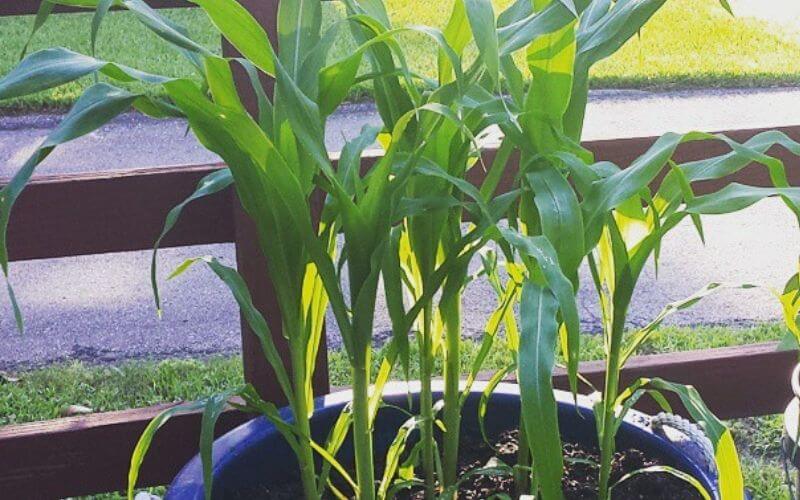
Do you dream of growing fresh, sweet corn at home but don’t have any yard to grow it? Don’t despair; you’ll be happy to find out that growing corn in pots is possible!
Many people don’t consider using containers to grow corn, and the yield will indeed be smaller than if you would grow corn in a garden.
However, with the right container and conditions, you can come as close as possible to the yield that you would receive if you grew corn in a garden bed.
When you think of growing corn, you might envision open fields, but most people don’t have wide-open areas and acres to grow their corn.
In reality, all you need is a spot that has plenty of sunlight, some wind, and the ability to keep the soil moist.
You might not consider growing corn in pots, but despite the difficulties, it’s worth a shot. It can be a fun experiment for your family to see how corn grows. Plus, homegrown sweet corn tastes so good.
To help you learn how to grow corn in your container garden, we put together a simple guide that walks you through all of the steps.
From picking the right pot to knowing how much your corn plants need to be walked, we covered everything you should know. So, let’s get started!
How to Start Growing Corn in Containers
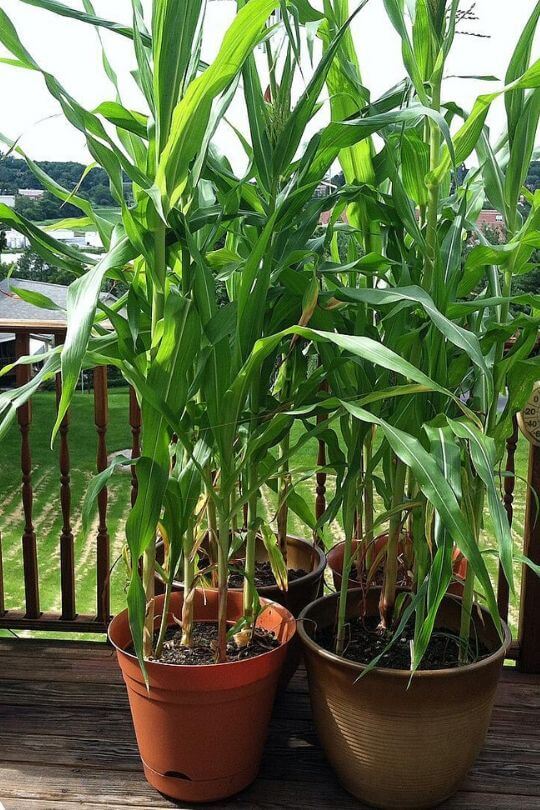
Growing corn is fun for adults and kids. Kids love to see the plants growing taller; hiding in corn stalks is always a fun game for kids.
If your family wants to try growing a few stalks of corn in your garden this year, here is what you need to do.
1. Choose The Variety Of Corn To Grow In Pots
So many people have no idea that there are different variations of corn. Not all corn is the type you munch on at the dinner table slathered in butter and salt.
Corn differs in several ways. There can be significant differences in mature height, internal kernel structure, texture, softness, and taste. Let’s look at the different types of corn that you can grow.
Sweet Corn
If you want to eat fresh corn at dinner, sweet corn is that type. It’s tender and juicy, the perfect side dish. Sweet corn is typically yellow, but it does come in different colors, such as brown and red.
Popcorn
Yes, you can grow popcorn, the same popcorn that you eat when you’re watching movies with friends. These kernels are hard and brittle.
The popcorn you know from the store is yellow-orange, but the popcorn that you can grow at home might even be blue!
Flint Corn
This type of corn has a hard outer layer that has a glassy appearance. It has a gummy-like texture. Just like popcorn, it can pop when heated, but it’s mostly used as hominy to make tortillas.
Flour Corn
This type of corn is often planted in the Southwest of the United States. Flour corn is starchy, but flour corn is soft and can be turned into finer cornmeal. It’s also sweet, and if you steam it or barbecue it, you can eat it off of the cob.
Dent Corn
Often called field corn, many farmers grow this kind of corn because it’s typically used for animal feed and processed food. It’s the most common raised corn in the US.
Dent corn dries up, and the soft center shrinks. That’s why the kernels appear dented, hence the name. You can use dent corn for cornmeal, or it can be dried to make hominy.
2. Know When To Plant Corn
Corn is a warm-weather crop that should be planted after the final frost dates for your growing season. It’s typically best to ait one or two weeks after your last frost date to make sure a rouge frost doesn’t bother or kill your new plants.
3. Pick The Right Pots For Corn
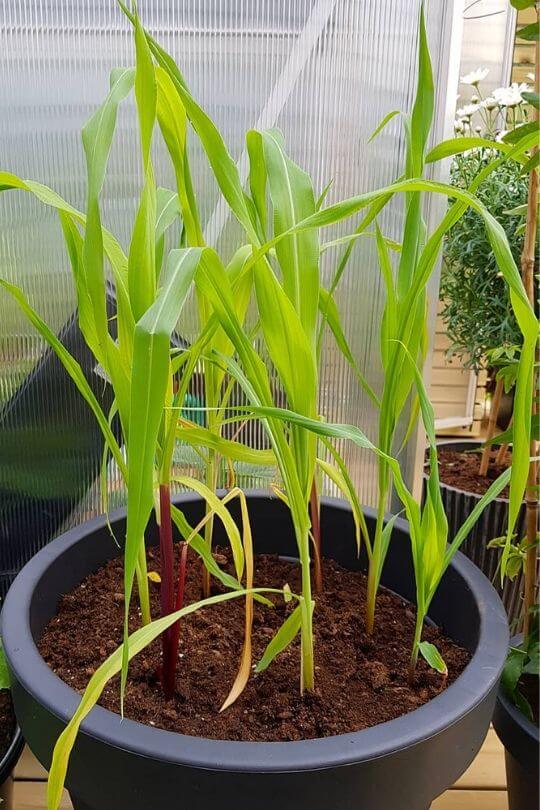
The hardest decision and most important is picking the right container to grow corn. You do need a large container that measures at least 12 inches deep and 12 inches wide. That’s the minimum size; you’ll probably want an even larger container.
You can be creative when selecting the pots for growing corn. Clay pots work, as well as plastic, but don’t stop there.
You can use laundry baskets, barrels, wooden crates, garbage cans, and whatever else you think might work.
In a container this size, you could grow four corn plants. So, you may need several containers depending on how many corn plants you want to grow and the size containers you select.
Aside from the size, you need to make sure that the pot you select has enough drainage holes in the bottom.
Corn needs moisture, but these plants don’t want standing water. So, drainage holes are a must. If your pot doesn’t have drainage holes, you can use a drill to create holes in the material.
4. Find The Right Spot For Your Container
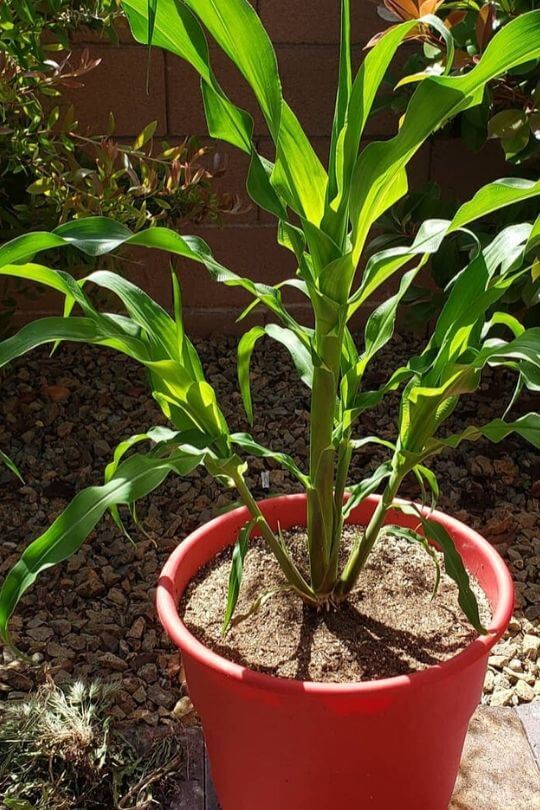
Corn is a warm-weather crop, and it needs plenty of sunlight to grow properly. Find a spot that receives six to eight hours of sunlight each day.
Something else to consider is that you can use corn plants as a privacy wall because the corn stalks grow tall quickly, even when growing in pots.
If you plant the corn in May, you can expect it to act as a screen by the middle of the summer. While container-grown corn will never reach the 12-15 feet heights associated with garden-grown corn, it does reach 6-8 feet tall easily.
5. Prepare Your Soil For Planting
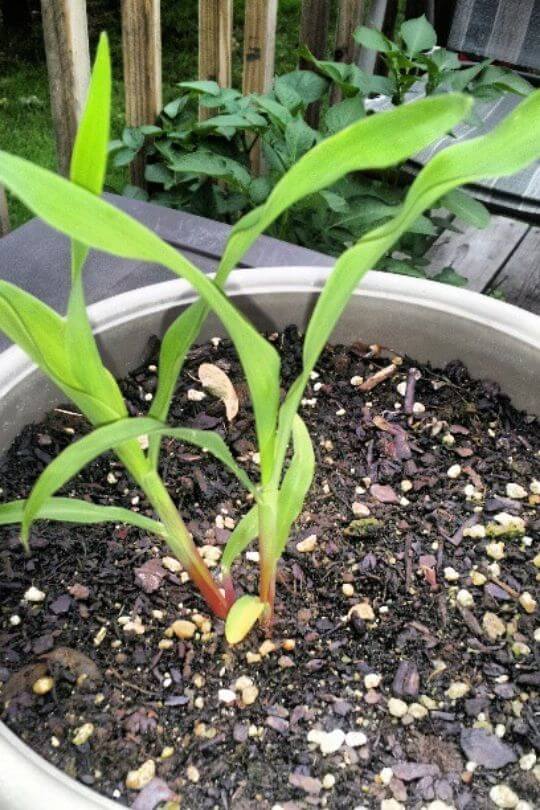
Now it’s time to prepare the soil to plant your corn seeds. Corn needs soil that retains moisture; it shouldn’t dry out too quickly.
At the same time, the soil should be well-draining to avoid the dirt becoming soggy or waterlogged.
One of the best choices is a peat-based potting soil. Consider adding compost, an all-purpose fertilizer, well-composted chicken manure, or some fish emulsion to the ground before planting. This helps add the nutrients that corn needs for the first weeks of growth.
It’s important to understand that corn is a heavy feeder. For farmers, corn can destroy the soil if it’s not replenished because it uses so much of the nutrients.
6. Plant Your Corn Seeds In The Pot
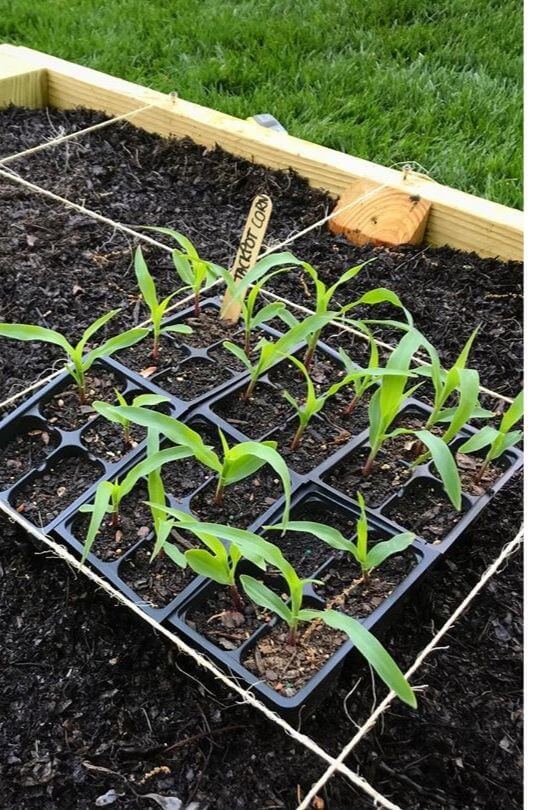
Now, it’s time to plant your corn seeds in the container that you selected. It’s so easy!
Plant four to six corn seeds per pot. Each seed should be planted 1 inch deep and cover it gently with some soil.
Don’t worry if you plant the corn closely together in the container because sowing seeds close helps with pollination, leading to more fruit. That’s a good thing!
You’ll want to plant each seed six inches apart along the outer circle of your pot. The seeds should be three to four inches from the edge of the container.
Once planted, make sure you water the seeds well. The sun will do the rest of the work for you.
It takes 10-14 days for corn seeds to germinate in cooler weather that is between 55 to 60℉. In temperatures 65℉ and above, it can take only six days to germinate.
Caring for the Corn Growing in Containers
Once planted, it’s time to take care of your corn. It’s straightforward, but remember, corn can be a bit tricky to grow in containers. You’ll need to pay a lot of attention to your crops.
1. Water Your Corn
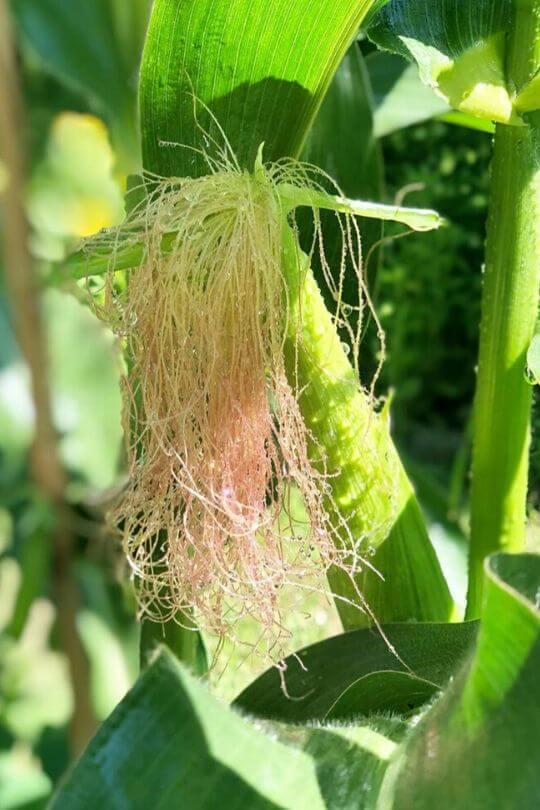
Corn does need plenty of moisture to grow. You should water the plants every other day, ensuring that the soil always has moisture.
Moisture is one of the key ingredients to delicious, sweet, soft corn, so that’s one of the reasons why water is so essential, especially at the time of fruiting.
When the plants are fruiting, you need to water your potted corn even more.
2. Use Fertilizers
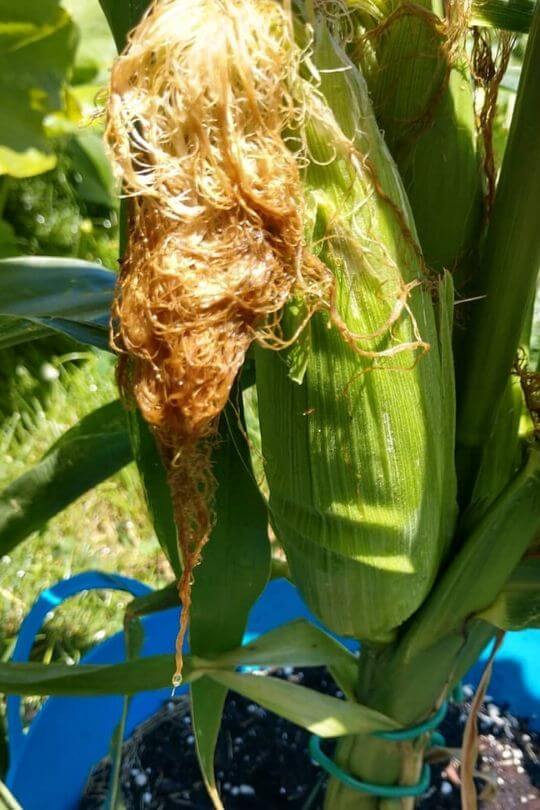
Ten weeks after you sow the corn seeds, you’ll want to apply fertilizer. Try using ½ tablespoon of 5-10-10 or 10-20-20 fertilizer for each plant. It’s best to dig a small hole near the plant and sprinkle the fertilizer, mixing it into the soil.
3. Don’t Forget To Mulch
Even though the corn is growing in a container, it’s not a bad idea to add mulch around the corn. Mulch helps to hold in moisture.
Wood chips, newspapers, and grass clippings are some excellent choices to help prevent moisture loss in the soil. Mulch also helps to reduce weed growth; no one likes weeds!
Common Pests & Diseases That Affect Corn
In general, corn is considered pest and disease-proof, but that doesn’t mean either couldn’t happen. Diseases and pests are always a possibility, so it’s good to know the common problems that your crops face
Corn Leaf Aphids
Aphids can be problematic for many different crops. A severe infestation can lead to stunted, deformed corn tassels. Your plant might look like it is covered in black mold.
Corn Flea Beetles
These beetles are active in the springtime. They start by infesting the weeds in the area, and then they move to the corn seedlings as they start to get bigger. You’ll know that you have a corn flea beetle infestation if you have small, circulator holes on your plant leaves.
Cutworms
This pest can affect most plants in your garden, not just corn. It moves from plant to plant, eating and devouring as it goes. Cutworms typically bother the top part of the plant, but in some cases, cutworms can eat the top crop.
Seed Corn Maggots
Here is a type of maggot that bothers crops typically in the spring. As you might tell by the name, they target corn seeds. If you’re still in the germination process, you need to pay attention to seed corn maggots.
Southern Corn Rootworm
As you might imagine, these insects love the roots of a corn plant, but it also targets the heart or bud of the plant. Check all of the leaves and the root areas to look for rootworms. They are small, so they can be hard to spot at times.
Harvesting Corn
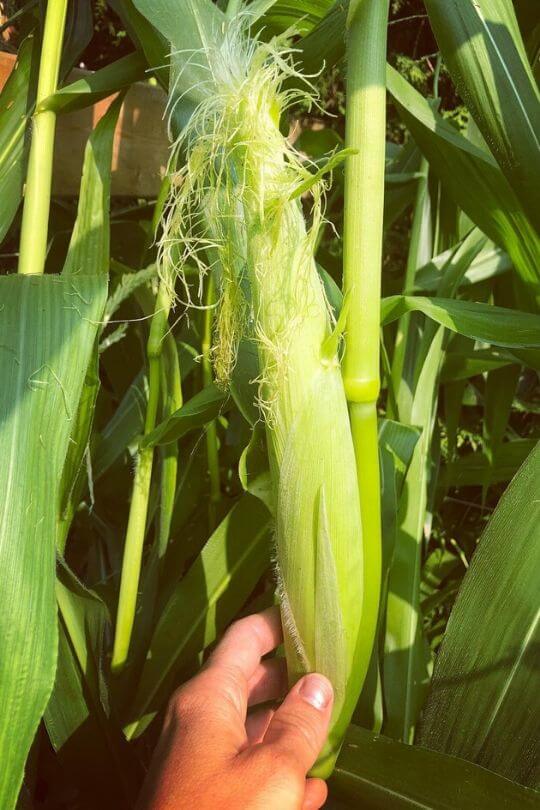
Harvesting corn growing in pots is essentially the same thing as harvesting corn in the garden. Most mature in 60-100 days, depending on the variety that you are growing and weather conditions.
You should understand that the harvest from container-grown corn might not be what you hoped. That’s why planting a container-friendly variety of corn and pay as much attention to the crops as possible.
Planting four stalks in each container and keeping them close together for the best pollination rates will ensure the best harvest possible.
The best time to harvest corn is in the early morning when the sweetness level is the highest.
When you’re ready to collect the corn, grasp the ear firmly, and pull downward. Then, twist and pull. It should come off of the stalk quickly.
Be sure that you’re only harvesting as much corn as you can eat within a few days.
The Best Varieties of Corn for Container Gardening
When you decide to grow corn in pots, you do want to make sure you pick the right type of corn. Ideally, you should select a dwarf variety that doesn’t exceed four to five feet tall.
Not only should you consider whether you want corn for ornamental purposes or eating, but you also need to think about pollination. Corn pollinates via the wind, so it’s quite easy for cross-pollination to take place.
It’s best to pick one type and only plant that unless you are able to separate the kinds of corn you planted.
Here are some varieties to consider growing.
Trinity

Here is an early sweet corn variety that produces eight-inch long ears. The kernels are super sweet and tender.
Trinity Corn is known for its reliable germination when planted in cool soil. The stalks tend to be around five feet tall.
Sweet Painted Mountain
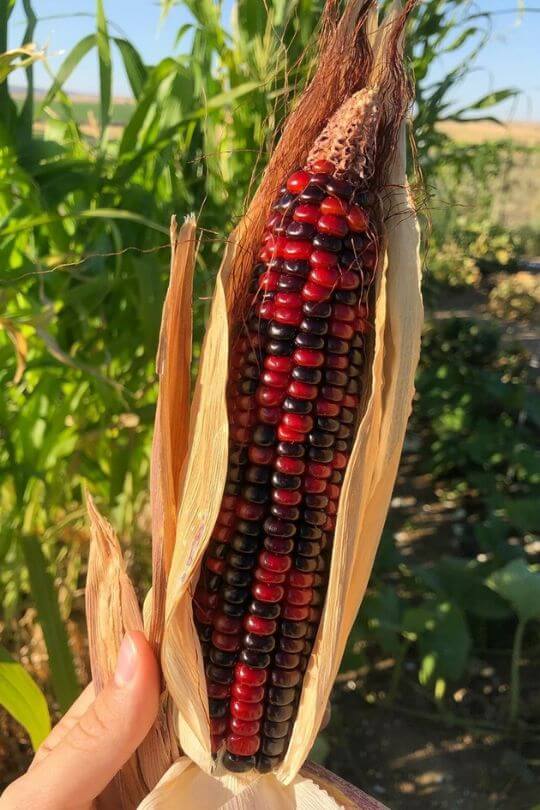
Here is a variety of corn that is beautiful. Originating in the cold regions of Montana, this corn is known for its cold hardiness and drought tolerance.
You can use this type of corn for eating or decoration. Sweet Painted Mountain corn can be eaten fresh, ground, or roasted.
Strawberry Popcorn
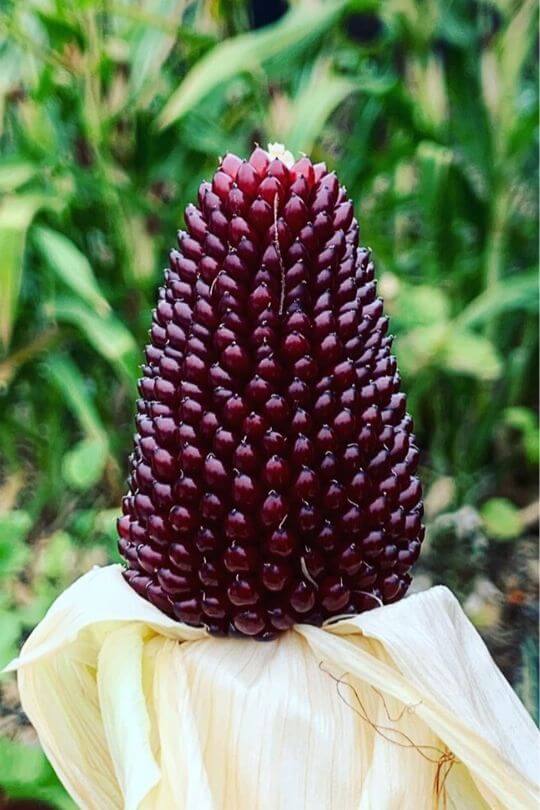
If you’re looking to grow popcorn in your container, Strawberry Popcorn produces little ears of corn that look like big strawberries that measure two to three inches long. The plants only reach heights of four feet, and each stalk grows two to four ears of corn.
Sweet Spring Treat
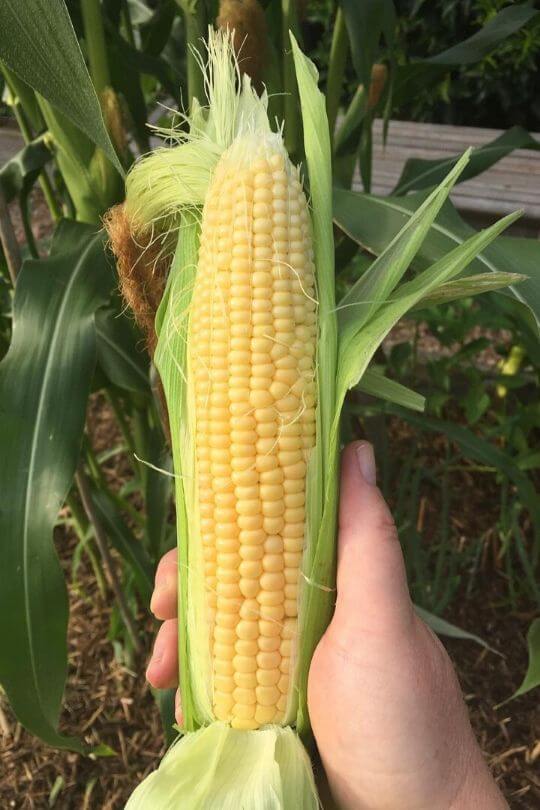
Here is early sweet corn that is ready to harvest in less than 70 days. The stalks reach five feet tall, and they’re known for being able to handle cool soil temperatures.
Chires Baby Sweet
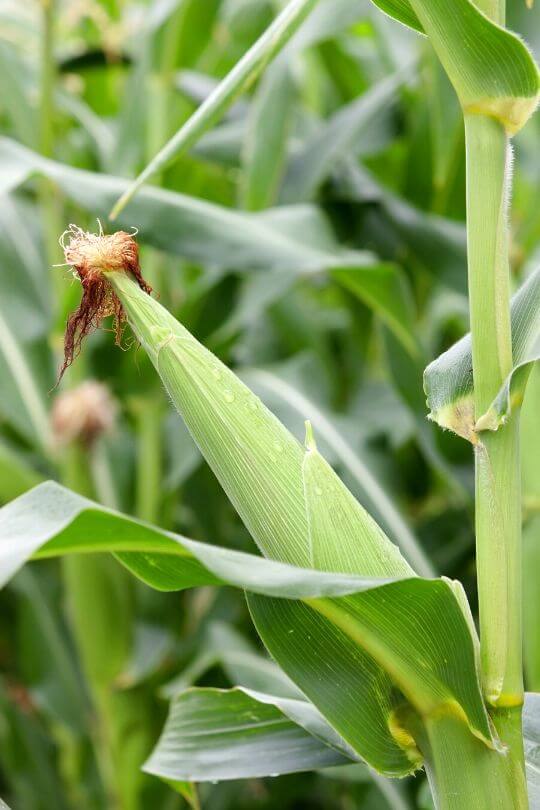
Here is a miniature corn variety that creates a high yield of corn. These are tiny ears of corn that you might call baby corn, similar to what you see in Chinese cooking. Each stalk can produce up to 20 tiny ears of corn.
Final Thoughts
When compared to other container gardening vegetables, corn isn’t as easy, and the yield that you’ll receive will be significantly smaller.
Growing corn in pots will require more attention and planning, but if you’re looking for a bit of a challenge, this might be something you want to try this summer.

Written By
Amber Noyes
Amber Noyes was born and raised in a suburban California town, San Mateo. She holds a master’s degree in horticulture from the University of California as well as a BS in Biology from the University of San Francisco. With experience working on an organic farm, water conservation research, farmers’ markets, and plant nursery, she understands what makes plants thrive and how we can better understand the connection between microclimate and plant health. When she’s not on the land, Amber loves informing people of new ideas/things related to gardening, especially organic gardening, houseplants, and growing plants in a small space.

Wonderful and easy to understand
Thank you
I am trying some vegetable gardening for the first time and can use all the help I can get 👍
Glad it helps 🙂
Hello:
I´m a studying the responses (morphological parameters) of corn cultivation in pots utilizing salinity soils and organic amendments. However, I´m not sure the amount of organic substrates to apply for each pot. I´ll be using plastic pots of 20 x 40 cm.
Corn variety is white (CP HS2) and the idea is to increase yield (ton/ha).
Thank you for your comment.
I am growing corn in a container should I by worried when I noticed some roots coming through drainage hole? They are 6ft tall.
Would I be able to plant several varieties or only one per season? I’m assuming the different varieties cross pollinate?
I’d like an eating corn and a popcorn.
All this was very helpful (and I am a former farmer). Many thanks, KMB.